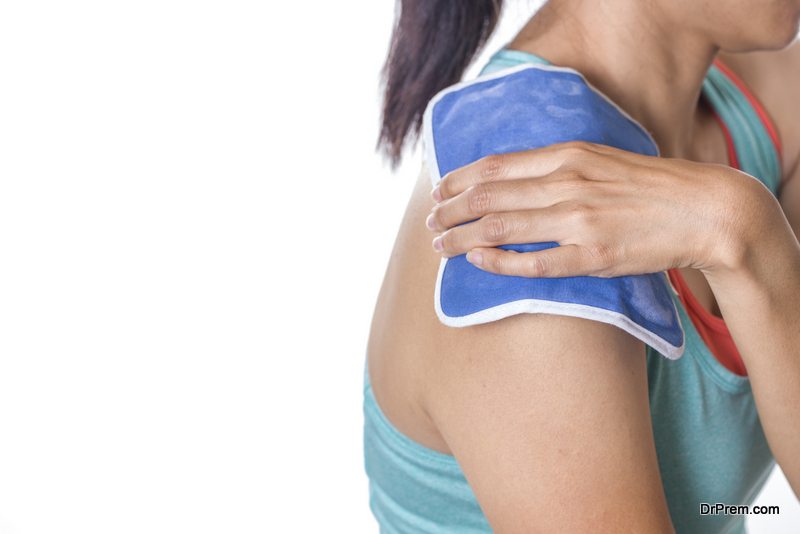If you’ve recently experienced an injury or you suffer from chronic pain, it’s sometimes difficult to decide if ice or heat is the better treatment. Which will bring you the much needed relief you’re after? Let’s take a look at some common injuries and ailments, and whether or not a heating pad or ice pack is best. We’ll also discuss how these extreme temperatures help ease your pain.
What They Do
Let’s start by discussing exactly what heat and ice do for injuries. Heat is most commonly used for muscle pain or stiffness. On the contrary, ice is used to treat any type of acute injury or pain. Ice is also used to help reduce swelling and inflammation.
If you’re still not clear on when you’ll need heat vs. ice for your injury, let’s take a closer look at specific ailments and analyze which temperatures will offer the most relief.
Heat Therapy

So, why exactly does heat offer relief for muscle pain? The increase in temperature improves your body’s circulation and blood flow to the area where it’s applied. Heat helps to increase the flexibility of your sore muscles. Not only does heat help to relax muscles, but it can even help heal any damaged tissue you might have.
There are two common types of heat therapy – dry or moist. Dry heat is what you’ll find when using a heating pad, saunas, or dry heat packs. Moist heat includes steaming towels, warm baths or showers, and moist heating packs. The benefits of moist heat over dry is that it acts faster at offering relief.
There are also different ways to apply your heat therapy options – local, regional, or whole body.
- Local – Exactly what it sounds like, local heat therapy is applied to a specific part of the body experiencing pain.
- Regional – This type of heat therapy helps address muscle stiffness over a larger area of the body.
- Whole body – Whole body heat therapy includes options like a hot bath, steam shower, or sauna to address overall body soreness and stiffness.
Heat therapy works better over long periods of time. You should apply heat for between 15 and 30 minutes, depending on the severity of your injury. But there are also times when heat therapy may not be right for you. If the source of your pain is either bruised or swollen, cold therapy might be best. If you have any kind of open wound, don’t apply any type of temperature therapy. Heat therapy can actually cause further damage to some preexisting medical conditions including:
- Diabetes
- MS
- Dermatitis
- Vascular disease
- Heart disease
- Hypertension
If you suffer from any of the above mentioned conditions, consult your physician before applying any type of heat therapy.
Risks
As with any medical treatment, heat therapy is not without risk. It’s important to think of heat therapy as applying something warm to the body, not hot. Exposing your body or skin to extreme heat can actually cause burns. If you suspect that your injury is accompanied with an infection, heat therapy can actually spread the infection. If you don’t feel relief after 5 to 7 days of heat therapy, you may need additional medication attention.
Cold Therapy

Now that we’ve covered exactly what heat therapy does, let’s take a look at the benefits of using cold therapy treatments.
Cold therapy, also known as cryotherapy, actually works by reducing blood flow to the injured area. This lack of blood flow can help reduce inflammation and swelling, which causes pain. Decreased blood flow also stunts nerve activity, offering pain relief. These type of injuries are most commonly found near and around tendons and joints.
Cold therapy options are relatively easy to use. Although mom’s frozen bag of peas may have worked in high school, there are some more advanced, recommended forms of cold therapy treatment available. Your typical ice pack can work wonders.
If you suffer from any type of nerve disorder, including diabetes, cold therapy treatments could be dangerous. People with poor circulation are also not good candidates for cold therapy, as their blood flow is already restricted. As mentioned before, for any type of stiffness or joint pain, cold therapy is not the best option. Heat therapy would be more beneficial.
Unlike heat therapy, which is often applied for longer periods of time, cold therapy should be used in short sessions, generally right after an injury occurs. Apply ice or cold therapy for between 10 and 20 minutes, but do not exceed 20 minutes per session. For added benefits, elevate the affected area. This helps to reduce swelling. If you’re using an ice pack, be sure to place a towel or other fabric between the ice pack and your skin. Frozen items placed directly on exposed skin can cause additional injuries.
Risks
Just as with heat therapy, cold therapy used for extended periods of time can cause skin, nerve or tissue damage. Cold therapy is not recommended for individuals with cardiovascular issues. The main purpose of cold therapy is to reduce swelling. If this does not occur within 48 hours, consult a medical professional.
Identify Your Injury First
The most important thing to remember when using heat or cold therapy is to first identify your injury. Using cold therapy on an injury that requires heat can cause additional injury, increased complications, and prolonged recovery. When in doubt, consult your physician. When using either heat or cold therapy, follow the guidelines above and you’ll be well on your way to recovery.
Article Submitted By Community Writer




